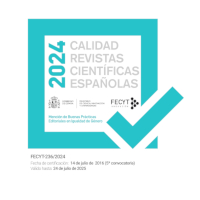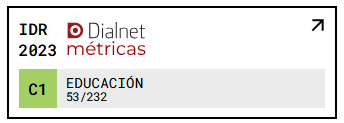Desarrollo cognitivo diferencial e intervención psicoeducativa
DOI:
https://doi.org/10.18172/con.488Resumen
En este artículo se revisa el concepto de desarrollo cognitivo desde una perspectiva neuroconstructivista actual y sus relaciones con la intervención psicoeduca-tiva. Desde esta perspectiva se postula que, para apresar el desarrollo en toda su ampli-tud multimodal, hay que atender al menos, a dos ejes: 1) el díferencial y, 2) la interacción (simétrica o asímétrica) como fenómenos incidentes de forma específica en cada uno de los cursos de desarrollo alternativos que se contemplan: la deficiencia menta! (y dentro de ella el Síndrome de Down) y las altas capacidades (y, dentro de ellas, la superdota-ción), postulando la necesidad de una intervención psicoeducativa ajustada a sus parti-cularidades, sin referencias anquilosantes provenientes de la perspectiva normativa = We propose a revision of the concept of cognitive development from a neuroconstructivist point of view and their relations with the psicoeducational practices. From this point of view, we postule that we must adopt two guide-lines in order to know as large as possible the concept of development: 1, the differential one, and, 2. interac-tion (symmetrical or asymmetrical) as specific phenomenon in mental deficiency (con-cretely in Down's Syndrome ones) and high intellectual abilities (concretely, giftedness). We postulate the necessity of a psicoeducational intervention adjusted to their capabili-ties and necessities without inmovilismsDescargas
Citas
Beegly, M., Perry, B. W. y Cicchetti, D. (1989). Structural and affective dimensions of play development in young children with down syndrome. International Journal of Behavioral Development, 12(2), 257-277.
Bidell,Th. R. y Fischer, K. W. (1997). Between nature and nurture: the role of human agency in the epigenesis of intgelligence. En R. J. Sternberg y E. Grigorenko (Eds.). Intelligence, Heredity and Environment, 193-242. New York, NY: Cambridge University Press.
Bruner, J. (1985). Vygotsky: a historical and conceptual perspective. En J. V. Wertsch (Ed.), Culture, communication and cognition: Vygotskian perspectives. Cambridge: Cambridge University Press.
Cambrodí, A. (1983). Principios de Psicología Evolutiva del Deficiente Mental. Barcelona: Herder.
Carvajal, F. e Iglesias, J. (1997). Mother and infant smiling exchanges during face-to-face interaction in infants with and without Down syndrome. Developmental Psychobiology, 31(4), 277-286.
Ceci, S. J. y Williams, W. (Eds.) (1999). The Nature-Nurture Debate. The essential readings. Oxford, UK: Blackwell.
Cicchetti, D. y Cohen, D. J. (1995). Developmental Psychopathology. Vol. 1. Theory and Research. New York: John Wiley & Sons.
Cicchetti, D. y Beeglhy, M. (Ed.) (1990). Children with Down Syndrome. New York: Cambridge University Press.
Cielinski, K. L.; Vaughn, B. et al. (1995). Relations among sustained engagement during play, quality of play, and mother-child interaction in samples of children with Down Syndorme and normally developing toddlers. Infant Behavior and Development, 18(2), 163-176.
Elman, J. L.; Bates, B.; Johnson, M. J.; Karmiloff-Smith, A. et al. (1996). Rethinking Innateness: A connectionist perspective on development. Cambridge, MA: MIT Press.
Florez, J. (1999). El Síndrome de Down: Presentación general. Siglo cero. 30(3), 7-27.
Flórez, J.; Troncoso, V. y Diersen, M. (1996). Síndrome de Down: biología, desarrollo y educación. Barcelona: Masson.
Gallagher, J. J. (2000). Unthinkable Thoughts: Education of Gifted Students. Gifted Child Quarterly, 44(1), 5-12
Galton, F. (1969). Hereditary genius: an enquiry into its laws and consequences. MacMillan: Londres.
Goswami, U. (1998). Cognition in Children. Hove, ES: Psychology Press Ltd, Publishers.
Hunt, E. (1997). Nature vs. Nurture: The feeling of vujà dé. En R. J. Sternberg y E. Grigorenko (Eds.). Intelligence, Heredity and Environment, 531-551. New York, NY: Cambridge University Press.
Johnson, M. H. (1997). Developmental Cognitive Neuroscience. London: Blackwell.
Karmiloff-Smith, A. (1994). Précis on Beyond Modularity: A developmental perspective on cognitive science. Behavioral and Brain Sciences, 17, 603-745.
Karmiloff-Smith, A. (1997). Promisory notes, genetic clocks, and epigenetic outcomes. Behavioral and Brain Sciences, 20(2), 355-360.
Knott, F.; Lewis, C. y Williams, T. (1995). Sibling interaction with learning disabilities: A comparison of autism and Down’s Syndrome. Journal of Child Psyhology and Psychiatry and allied disciplines, 36(6), 965-976.
Krippendorf, Kl. (1980). Content analysis. An introduction to its methodology. Vol. V. London: Sage Publications.
Lamb, M. E. (1997). The role of the father in Child Development. Canada: John Wiley & Sons, Inc.
Langer, J. (1986). The origins of Logic. One to two years. New York: Academic Press.
Langer, J. (1990). Early cognitive development: Basic functions. En C. A. Hauert (Ed.) Developmental psychology: Cognitive, perceptuo-motor and neuropsychological perspectives. (pp. 19-42). Amsterdam: North Holland.
Lemetayer-Baron, F. (1997). Tutelles parentales et déficience mentale. Thèse de doctorat inédite Université de Rennes.
Lombroso, C. (1896). The man of genius. Scott: Londres.
Magnusson, M. (1993). Thème behavior resarch software. Reykjavik: Unpublished Manuscript University of Iceland.
Magnusson,M. (1996). Hidden real-time patterns in intra and interindividual behavior: description and detection. European Journal of Psychological Assessment, 12(2), 112-123.
McConachie, H. (1989). Mother’s and Father’s interaction with their young mentally handicapped children. International Journal of Behavioral Devleopment, 12(2).
Mounoud, P. (1994). Le passage de répresentations partielles à des répresentations d’ensemble. Enfance, 48(1), 5-32.
Piaget, J. y García, R. (1987). Vers une logique des significations. Ginebra: Murion Editeur. (Trad. cast. Hacia una lógica de significaciones. Barcelona: Gedisa, 1.991).
Piaget, J. (1953). The origins of intelligence in childhood. New York: International Univ. Press.
Plomin, R. y Petrill, S. A. (1997). Genetics and Intelligence: What’s new?. Intelligence, 24(1), 53-78.
Plomin, R. y Rutter, M. (1998). Child Development, Molecular Genetics and What to Do with Genes Once they are Found. Child Development, 69, 1223-1242.
Quartz, S. R. y Sejnowski, T. J. (1997). The Neural basis of cognitive development: A constructivist manifesto. Behavioral and Brain Sciences, 20, 537-596.
Renshaw, P. D. y Gardner, R. (1990). Process versus product task interpretation and parental teaching practice. International Journal of Behavioral Development, 13(4), 489-505.
Renzulli, J. S. (1999). What is this Thing Called Giftedness, and How Do We Develop It? A Twenty-Five Year perspective. Journal for the Education of the Gifted, 23(1), 3-54.
Sastre, S. (1991). Estudio comparativo sobre la influencia del adulto en la actividad cognitiva del niño trisómico-niño normal entre 0;11a.-1;6a. Tesis Doctoral no publicada. Universidad de Barcelona
Sastre, S. y Pastor, E. (1992). Vers una interpretació constructiu-contextualista de la deficiència: l'adult com a mediador. Rev. de Psicologia Universitas Tarraconensis XIII(1),125-134.
Sastre, S. y Pastor, E. (1994). Action, Signification Process and Scaffolding Organization. XIIIth Biennal of ISSBD. Amsterdam.
Sastre, S. y Acereda, A. (1998). El conocimiento de la superdotación en el ámbito educativo formal. Faísca, 6, 3-25.
Sastre, S. y Domènech, M. (1999). La identificación diferencial de la superdotación y el talento. Faísca, 7, 23-49.
Sastre, S. y Pastor, E. ( 2001). Modalidades de tutela de gestión cognitiva en bebés trisómicos. infancia y Aprendizaje, 93, 35-52
Sastre, S. y Verba, M. (en prensa). Les interactions de tutelle avec les bébés trisomiques et les bébés typiques: le rôle de l'ajustement de l'adulte. Enfance.
Scarr, S. (1997). Behavior-Genetic and Socialization theories of ingtelligence. Truce and reconciliation. En R. J. Sternberg y E. Grigorenko (Eds.). Intelligence, Heredity and Environment, 3-41. New York, NY: Cambridge University Press.
Sinclair, H.; Stambak, M.; Lezine, I.; Rayna, S. y Verba, M. (1984). Los bebés y las cosas. Barcelona: Gedisa (orig. 1982).
Sternberg, R. J. y Grigorenko, E. (Eds.) (1997). Intelligence, Heredity and Environment. New York, NY: Cambridge University Press.
Tannenmbaum, A. J. (1998). Programs for the Gifted: To Be or not To Be. Journal for the Education of the Gifted, 22(1), 3-36.
Taylor, S.; Langer, J.; McKinney, M. L. (2000). Biology, Brains nd Behavior. The evolution of Human Development. Santa Fe, N.M: School of American Research Press.
Terman, L. M. (1925). Genetics studies of genius. Standford University press: California.
Van Tassel-Baska, J. (1998). Gifted and Talented Learners. Denver, C.: Love Publishing Company.
Verba, M. (1994). The beginnings of collaboration in Peer interaction. Human Development, 37, 125-139.
Waldman, I. D. (1997). Unresolved questions and future directions in behavior-genetic studies of ingtelligence. En R. J. Sternberg y E. Grigorenko (Eds.). Intelligence, Heredity and Environment, 552-570. New York, NY: Cambridge University Press.
Wood, D. J. (1989). Social interaction as tutoring. En M. H. Bornstein y J. S. Bruner (Eds.). Interaction in human development. Hillsdale, NJ: LEA.
Descargas
Publicado
Cómo citar
Número
Sección
Licencia
El autor o autora conserva todos los derechos sobre su artículo y cede a la revista el derecho de la primera publicación, no siendo necesaria la autorización de la revista para su difusión una vez publicado. Una vez publicada la versión del editor el autor está obligado a hacer referencia a ella en las versiones archivadas en los repositorios personales o institucionales.
El artículo se publicará con una licencia Creative Commons de Atribución, que permite a terceros utilizar lo publicado siempre que se mencione la autoría del trabajo y la primera publicación en esta revista.
Se recomienda a los autores/as el archivo de la versión de editor en repositorios institucionales.













